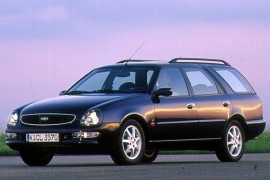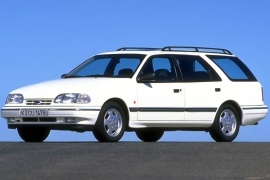FORD Scorpio Wagon Models/Series Timeline, Specifications & Photos
First production year: 1992
Engines: Gasoline, Diesel
Body style: Wagon (station wagon, estate, combi, touring)
Ford already introduced the Mondeo on the European market but still tried to fight in the executive segment with its aging Scorpio, in two shapes: a sedan and a station wagon.
While in the U.S., the blue-oval brand managed to develop good, affordable vehicles on the European side of the pond, it couldn't keep up with other brands. It was the last rear-wheel-drive station wagon sold by Ford in Europe and fought mainly against GM's Opel/Vauxhall Omega. But both of them were on their final stint before their parents shut them down for good.
The Scorpio Wagon showed the same front fascia as the sedan, with an undecided shape of the headlights. They looked rounded triangular-shaped and flanked the smiling grille. But it was more of a grin than a smile, and its chromed surrounding didn't make things better. Behind the B-pillars, the carmaker extended the roof to the back of the vehicle. It even used the same rear doors to cut costs, leading to raked-forward rear side windows and tailgate.
Inside, the Scorpio featured an upgraded interior with a dashboard centered around the driver. Its center stack featured the climate control units above the radio cassette player. Ford placed the elegant, round, analog clock in a position where the driver couldn't see it most of the time due to the steering wheel. It was a roomy vehicle, with plenty of room for four passengers, but the old platform with a tall transmission tunnel made it unusable for a third person unless it was a toddler in a child seat. On the plus side, the folding bench increased the trunk size.
Under the hood, Ford installed a choice of diesel and gasoline engines. They were either slow or inadequate on fuel efficiency. The turbo-diesel version was reasonable in terms of fuel efficiency and performance.
Along with the second facelift for the Scorpio Sedan, Ford introduced a station wagon for its biggest car on the European market: the Scorpio Wagon.
Ford introduced the wagon version for the Scorpio in 1992 to regain a part of the executive market that it lost after switching from the three-box Granada to the hatchback Scorpio in 1985. While its move didn't work as expected, at least it slowed down the drop in sales. Starting with 1992, it also introduced a new engine range. Ford learned that the Peugeot engines were too slow and opted to use only the WM Motori turbocharged units.
The Wagon shared its front fascia with the sedan version. It featured bigger headlights and redesigned bumpers. Ford kept the same rear doors from the sedan, but it extended the roof and added an oddly-looking rear set of windows for the trunk area. The designers made a vertical drop for the tailgate and added small taillights mounted on the quarter panels' back in the rear.
The interior was far better, with smoother lines on the dashboard. It even featured a center stack with the HVAC controls placed on the top and the audio controls underneath them. It improved the sound-deadening materials, and the fittings inside finally matched those installed on the BMW 5-Series. The Ghia trim-level featured power seats, leather upholstery, and wood-trims on the dash and door panels.
Under the hood, Ford dropped the carbureted engines and improved the efficiency for the others. But the car was still unconvincing from the performance point of view. The base version provided 120 hp, but it was from the 1990 model-year. The Cosworth 2.9-liter engine was powerful enough to propel the vehicle well beyond 120 mph (194 kph), but it was still thirsty.

